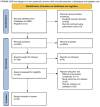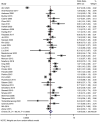Efficacy of mechanical against manual method in cardiopulmonary resuscitation for out‑of‑hospital cardiac arrest: A meta‑analysis
- PMID: 39478734
- PMCID: PMC11523225
- DOI: 10.3892/etm.2024.12748
Efficacy of mechanical against manual method in cardiopulmonary resuscitation for out‑of‑hospital cardiac arrest: A meta‑analysis
Abstract
Out-of-hospital cardiac arrest (OHCA) remains a leading cause of mortality worldwide, with the efficacy of cardiopulmonary resuscitation (CPR) methods playing a crucial role in patient outcomes. The present study aimed to compare the effectiveness of mechanical and manual CPR in OHCA, focusing on three outcomes: Return of spontaneous circulation (ROSC), survival to admission and survival till discharge. A comprehensive meta-analysis was conducted, incorporating 39 studies for ROSC, 28 for survival to admission, and 30 for survival till discharge, totalling 144,430, 130,499 and 162,088 participants, respectively. The quality of evidence was evaluated using the GRADE approach, assessing risk of bias, inconsistency, indirectness, imprecision and publication bias. Statistical analysis included pooled odds ratios (ORs) with 95% confidence intervals (CIs) and sensitivity analyses. For ROSC, the pooled OR was 1.09 (95% CI: 0.92-1.29), demonstrating no significant difference between mechanical and manual CPR. Survival to admission favoured mechanical CPR with a pooled OR of 1.25 (95% CI: 1.09-1.43). No conclusive difference was found for survival till discharge, with a pooled OR of 0.79 (95% CI: 0.61-1.02). Substantial heterogeneity was observed across outcomes. Evidence of potential publication bias was noted, particularly in the survival to admission outcome. The overall quality of evidence was graded as very low, mainly due to high heterogeneity and indirectness of evidence. The study suggests that mechanical CPR may improve short-term outcomes such as survival to admission in patients with OHCA but does not demonstrate a significant long-term survival benefit over manual CPR.
Keywords: cardiopulmonary resuscitation; meta-analysis; out of hospital cardiac arrest.
Copyright: © 2024 Zhu and Fu.
Conflict of interest statement
The authors declare that they have no competing interests.
Figures




Similar articles
-
A meta-analysis of the resuscitative effects of mechanical and manual chest compression in out-of-hospital cardiac arrest patients.Crit Care. 2019 Mar 27;23(1):100. doi: 10.1186/s13054-019-2389-6. Crit Care. 2019. PMID: 30917840 Free PMC article.
-
Prognostic Impact of In-Hospital Use of Mechanical Cardiopulmonary Resuscitation Devices Compared with Manual Cardiopulmonary Resuscitation: A Nationwide Population-Based Observational Study in South Korea.Medicina (Kaunas). 2022 Feb 27;58(3):353. doi: 10.3390/medicina58030353. Medicina (Kaunas). 2022. PMID: 35334529 Free PMC article.
-
Mechanical versus manual cardiopulmonary resuscitation (CPR): an umbrella review of contemporary systematic reviews and more.Crit Care. 2024 Jul 30;28(1):259. doi: 10.1186/s13054-024-05037-4. Crit Care. 2024. PMID: 39080740 Free PMC article.
-
Mechanical versus manual chest compressions for cardiac arrest.Cochrane Database Syst Rev. 2018 Aug 20;8(8):CD007260. doi: 10.1002/14651858.CD007260.pub4. Cochrane Database Syst Rev. 2018. PMID: 30125048 Free PMC article.
-
Comparison between Prehospital Mechanical Cardiopulmonary Resuscitation (CPR) Devices and Manual CPR for Out-of-Hospital Cardiac Arrest: A Systematic Review, Meta-Analysis, and Trial Sequential Analysis.J Clin Med. 2022 Mar 7;11(5):1448. doi: 10.3390/jcm11051448. J Clin Med. 2022. PMID: 35268537 Free PMC article. Review.
References
-
- Committee on the Treatment of Cardiac Arrest; Current Status and Future Directions; Board on Health Sciences Policy and Institute of Medicine: Strategies to Improve Cardiac Arrest Survival: A Time to Act. Graham R, McCoy MA and Schultz AM (eds). National Academies Press, Washington, DC, 2015. - PubMed
-
- Goyal A, Sciammarella JC, Cusick AS, Patel PH. Cardiopul-monary resuscitation. In: StatPearls [Internet]. StatPearls Publishing, Treasure Island, FL, 2024.
LinkOut - more resources
Full Text Sources
